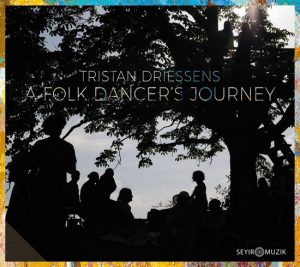 Wars van stijlkenmerken waagt globetrotter en ûd (Arabische luit) speler Tristan Driessens zich op het wereldtoneel met het verbluffend mooie album ‘A folk dancer’s Journey’. Bijgestaan door iets meer dan een dozijn musici, klinken er weelderige composities voor de avontuurlijke luisteraar.
Wars van stijlkenmerken waagt globetrotter en ûd (Arabische luit) speler Tristan Driessens zich op het wereldtoneel met het verbluffend mooie album ‘A folk dancer’s Journey’. Bijgestaan door iets meer dan een dozijn musici, klinken er weelderige composities voor de avontuurlijke luisteraar.
English version below
De ûd (Arabische luit) is de piano van het oosten. De Arabische muziek wordt gecomponeerd vanuit de ûd zoals dat in de westerse muziek gebeurt vanuit de piano. Een van de grootste ûd-spelers was Munir Bashir (1930–1997) uit Irak. Een musicus die grote invloed heeft gehad op de ontwikkeling van de ûd-muziek. Maar er zijn zeer veel innovatieve ûd-spelers die het instrument tegenwoordig combineren met westerse muziek zoals Rabih Abou-Khalil, Anouar Brahem en Dhafer Youssef. Aan dit rijtje kunnen we met gemak de Vlaamse musicus Tristan Driessens toevoegen. Een breed georiënteerde muzikant die met zijn nieuwe album ‘A folk dancer’s journey’ minutieus laveert door de Noord-Afrikaanse muziek (2de gedeelte van ‘Mandragora’s Jig’) waarin de quaraqeb (stalen castagnettes) te horen zijn. Of door de Ethiopische signatuur, die klinkt in ‘Alethea’s First Song’ met zijn typische toonladder die zo kenmerkend is voor de Ethiopische muziek. Griekse kleuren horen we in ‘Greek Dance’, het Turkse ‘L’Assamblée des Oiseaux’, het erg mooie en melancholische ‘Lev Tahor’ (Armeens) en de frisse folkmuziek in ‘Slängpolska’. Hij wordt bijgestaan door muzikanten op o.a. draailier, (blok)fluit, cello, kanun (snaarinstrument), klarinet, harp, duduk (Armeens dubbelriet: soort hobo) en percussie. Een bonte verzameling instrumenten die fraai zijn verwerkt in de composities, avontuurlijk gearrangeerd in de overwegend door Tristan Driessen geschreven stukken. Een muzikale wereldreiziger die met ‘A folk dancer’s journey’ een tijdloos album aflevert.
English version
The globetrotter and ûd (Arabic lute) player Tristan Driessens ventures out onto the world with the stunningly beautiful album ‘A folk dancer’s Journey’. With more than a dozen musicians, he plays lovely compositions for the adventurous listener.
The ûd (Arabic lute) is the piano of the east. The Arabic music is composed with the ûd in the centre like the piano in western music. One of the best ûd players was Munir Bashir (1930-1997) from Iraq. A musician who has had a major influence on the development of ûd music. Nowadays there are many innovative ûd players who combine the instrument with western music such as Rabih Abou-Khalil, Anouar Brahem and Dhafer Youssef. We can easily add the Flemish musician Tristan Driessens to this list. A broadly oriented musician who meticulously puts North African music (Second part of ‘Mandragora’s Jig’, with the quaraqeb – steel castagnettes) in the music on his new album ‘A folk dancer’s journey’. Or the Ethiopian signature in ‘Alethea’s First Song’ with his typical (pentatonic) scale. Greek colours in ‘Greek Dance’, the Turkish sound of ‘L’Assamblée des Oiseaux’. Or the very beautiful and melancholic ‘Lev Tahor’ (Armenian) and the fresh folk music in ‘Slängpolska’. He is assisted by musicians on, among others, hurdy-gurdy, recorder, cello, kanun (string instrument), clarinet, harp, duduk (Armenian double reed: oboe type) and percussion. A fine colourful collection of instruments that have been beautifully incorporated into the compositions, arranged in an adventurous way and mostly written by Tristan Driessen. A great musican and a musical world traveller who delivers a timeless album with ‘A folk dancer’s journey’.
- Tristan Driessens: ‘A folk dancer’s journey’ (Seyir Music / Xango)
© Mattie Poels.

Geen reacties